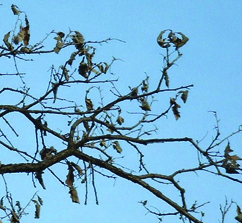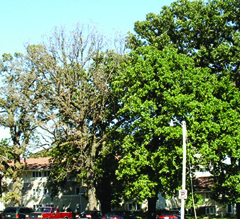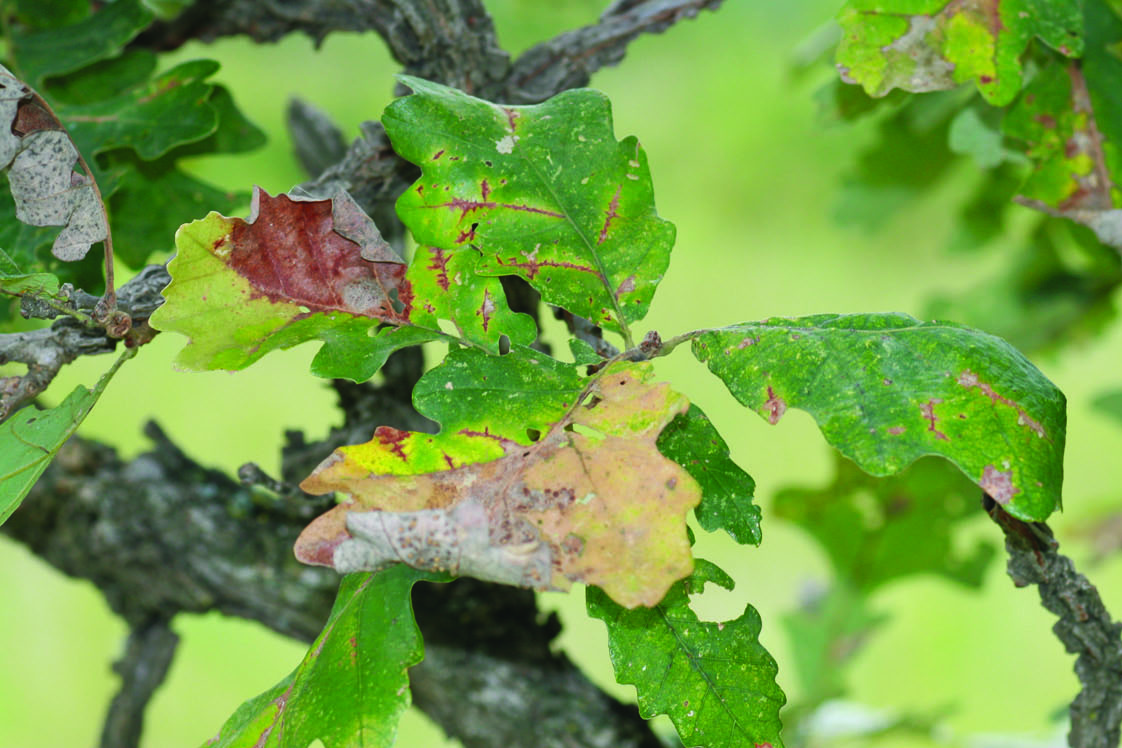From an Article published by US FOREST SERVICE:
Bur Oak Blight
A serious leaf blight disease on bur oak has been recognized in several Midwestern States since the 1990s with Iowa reporting its first occurrence of this disease 6 or 7 years ago. A common leafspot fungus, Tubakia dryina, was initially thought to be the cause of the blight on bur oak, but closer examination revealed a different story. Researchers in Iowa confirmed that this disease is caused by a new, and yet unnamed, species of Tubakia. The disease was named bur oak blight, or BOB for short.
There are now five known species of Tubakia that can infect bur oak in Iowa, but only one species causes dramatic leaf symptoms and tree mortality characteristic of BOB.
Hosts and Distribution
BOB occurs only on bur oaks. Severe symptoms of BOB have been observed only on Quercus macrocarpa var. oliviformis, a variety of bur oak that produces smaller acorns. BOB occurs primarily on naturally established trees, and especially on mature trees on upland sites that appear to be remnants of savannah forests. Bur oak growing in dense forests and on bottomland sites is less seriously affected.
It is not clear if this new species of Tubakia is a recent arrival to this region or if a shift in climate (more early-season rain events) has made this disease more noticeable over the last two decades. To date, the BOB fungus is known to occur from northeastern Kansas and eastern Nebraska to central Minnesota and southwestern Wisconsin, and across most of Iowa. This disease is most severe in eastern Nebraska, Iowa, and Minnesota, which coincides closely with the distribution of Quercus macrocarpa var. oliviformis. A few affected trees have also been identified in Illinois and Missouri.
Symptoms
Leaf symptoms typically first appear in late July or August. Infected leaves develop purple-brown lesions along the midvein and major lateral veins on the underside of leaves (figure 1). As the lesions increase in size, dark veins become noticeable on the upper leaf surface (figure 2). Large, wedge-shaped areas of chlorosis and necrosis develop on the leaf blade, and major leaf mortality may occur (figure 2). Individual lesions may coalesce and cause large areas of the leaf to die, giving it an overall wilted or scorched appearance (figure 3). The symptoms of wilting and leaf scorch resemble, and have been confused with, symptoms induced by oak wilt.
During the summer, black fruiting structures of the fungus form along the dark leaf veins and produce rain-splashed spores. These fruiting bodies can be seen with the aid of a 10X magnifying lens (figure 4). Later in the season, black pustules (fruiting bodies of the fungus) develop on the petioles of infected leaves (figure 5), and mature spores are seen in these pustules the next spring.
 A unique feature of BOB is that some of the killed leaves remain on the tree during the winter (healthy bur oak trees shed all of their leaves in the fall). Not all infected leaves, however, remain attached. Some leaves drop off during the growing season and some are blown off by winter winds (figure 6). If BOB-infected leaves drop or are blown off, their petioles typically remain attached to the tree. The disease can be confirmed by microscopic examination of the pustules that form on the petiole base.
A unique feature of BOB is that some of the killed leaves remain on the tree during the winter (healthy bur oak trees shed all of their leaves in the fall). Not all infected leaves, however, remain attached. Some leaves drop off during the growing season and some are blown off by winter winds (figure 6). If BOB-infected leaves drop or are blown off, their petioles typically remain attached to the tree. The disease can be confirmed by microscopic examination of the pustules that form on the petiole base.
The disease tends to intensify from year to year in individual trees. If only a portion of the crown is affected, BOB symptoms usually start in the lower branches and progress up the tree. If a tree is seriously affected one year, it tends to be severely affected the next year. BOB appears to spread slowly, particularly from tree to tree. It remains a mystery why BOB does not spread more rapidly given the great abundance of spores that cause BOB and their spread by rain.
 Not all stands of bur oak are seriously affected by this disease. Even within a seriously affected stand, not all trees are equally susceptible. Some trees may be severely infected while adjacent trees appear healthy (figure 7). This is likely due to variation in the resistance of individual bur oak trees to this disease.
Not all stands of bur oak are seriously affected by this disease. Even within a seriously affected stand, not all trees are equally susceptible. Some trees may be severely infected while adjacent trees appear healthy (figure 7). This is likely due to variation in the resistance of individual bur oak trees to this disease.
Management
Over time, severely affected trees may die. Tree death is usually associated with severe blight over many years and damage caused by secondary invaders such as the two-lined chestnut borer and Armillaria root rot. Boosting tree vigor may prolong the life of affected trees and ward off invasion by secondary pests. Because the fungus overwinters on infected leaf petioles that remain on the tree, removing fallen leaves is not an effective management tool. In preliminary studies, injections with a triazole fungicide in late May or early June (prior to leaf symptoms) have reduced symptom development in the fall and the following year. With further study, fungicide treatments may have value in managing high-value landscape trees.


